|
|
|
Sort Order |
|
|
|
Items / Page
|
|
|
|
|
|
|
| Srl | Item |
| 1 |
ID:
152492
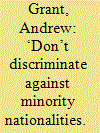

|
|
|
|
|
| Summary/Abstract |
Through an analysis of popular posts Tibetans shared over the social media application WeChat in 2013 and 2014 and offline discussions about them, this paper shows how Tibetans living in and traveling through Xining City practiced and performed their ethnic identity in the face of perceived harassment. Through their viral posts, they created a cyber-community that contributed to Tibetan ethnic group formation when Tibetans interpreted their ethnic identity as the basis for unjust treatment by the Chinese state and private Han individuals. In online posts the Han are portrayed as harassing Tibetans after terror attacks across China, violating minzu rights, denigrating Tibetan culture and territory, and denying Tibetans equal footing as modern compatriots. Social media are changing the ‘representational politics’ of Tibetan ethnicity, altering participation in the representation of the Tibetan ethnic group. Still, online discourse remains subject to constraints; private offline discussions remain important fora of opinion exchange.
|
|
|
|
|
|
|
|
|
|
|
|
|
|
|
|
| 2 |
ID:
152489
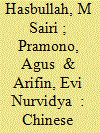

|
|
|
|
|
| Summary/Abstract |
This paper provides new statistics to the debate on percentage of Chinese Indonesians, using the latest 100% data set of the 2010 population census. It reveals that the statistics is closer to the low side of the debate, less than 2.0%, rather than the high side of 3.0% and more. Ethnicity is here self-defined by the respondents. With 1.2%, the Chinese Indonesians ranked as the 15th largest group of more than 600 ethnic groups. This paper also produces statistics at the district level, the first ever statistics on Chinese Indonesians. It finds that some provinces and districts have large percentages of Chinese Indonesians, but the respective total population are relatively small to the total Indonesia’s population. Majority of provinces and districts (25 out of 33 provinces and 415 out of 497 districts) have lower percentage of Chinese than the national figure.
|
|
|
|
|
|
|
|
|
|
|
|
|
|
|
|
| 3 |
ID:
152487
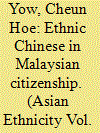

|
|
|
|
|
| Summary/Abstract |
The ethnic Chinese in Malaysia are a significant minority who call for a critical assessment as far as their cultural identity and political positioning are concerned. Appropriating the concept of ‘multicultural citizenship’, this article attempts to dissect various demands and aspirations of the ethnic Chinese in Malaysia’s multiracial hierarchy. It suggests that using the lens of multicultural citizenship can help shed light on Malaysian Chinese as well as the entire nation, where ethnicity and citizenship are gridlocked in historical formation and political hierarchy. In recent times, Malaysian Chinese have articulated their political desires and demands in order to get rid of the disgrace of racial constraints, and also to envisage a more inclusive multicultural citizenship for Malaysia as a nation-state. This article also compares and contrasts three Chinese public figures who have taken disparate stands and approaches with regard to language, culture, race, nation, and party politics.
|
|
|
|
|
|
|
|
|
|
|
|
|
|
|
|
| 4 |
ID:
152490
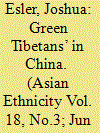

|
|
|
|
|
| Summary/Abstract |
This article examines how certain Tibetans and Han Chinese converts to Tibetan Buddhism in Diqing Tibetan Autonomous Prefecture and Beijing are articulating various forms of environmental discourse, both in terms drawn from Tibetan ‘geopiety’, and/or from a Western model of environmental protection. In relation to these trends, I further explore how certain Tibetans are articulating their understanding of Tibetan Buddhism within an apparently localised context, while other Tibetans are more obviously appropriating from discourses originating in the West and/or wider Chinese society to become more ‘modern’, while at the same time retaining a conceptualisation of Tibetan Buddhism that is hybridised between traditional and modernist understandings. I also explore how some Han practitioners may seek to become more ‘Tibetan’ by endorsing localised forms of Tibetan Buddhism and/or ‘performing’ certain Tibetan modes of religiosity, while others, due in part to geographical distance from the Tibetan landscape and cultural context, endorse an understanding of Tibetan Buddhism which is more closely tied to discourses of environmental protection originating in the West. In both Tibetan and Han Chinese cases, informants reflect upon their own beliefs and identity by gazing at the Other (Tibetan, Han, or Westerner), and marking out differences and similarities between Self and Other.
|
|
|
|
|
|
|
|
|
|
|
|
|
|
|
|
| 5 |
ID:
152488
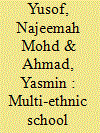

|
|
|
|
|
| Summary/Abstract |
This study aims to identify the challenges and approaches to improve a multicultural competency among teachers in multi-ethnic schools environment based on school leaders’ perspective. Data collection method used in this study is qualitative method. A total of nine school leaders from the states of Kedah, Penang, and Perak were included in the interview session. The results of this study show that the challenges faced by teachers in practicing the multicultural competency are lack of experience toward cultural diversity. A late exposure to cultural diversity makes it difficult for teachers to accept and adapt in a multi-ethnic school environment. The approaches suggested by school leaders to improve the multicultural competency are as follows: (1) Courses on cultural diversity should be organized to enhance the knowledge about cultural diversity; (2) the development of more open and better policy for education system in Malaysia in order to prepare teachers with a higher multicultural competency for teaching students from diverse ethnic and cultural groups; (3) an early exposure to cultural diversity in order to increase the multicultural competency, especially during teaching practicum.
|
|
|
|
|
|
|
|
|
|
|
|
|
|
|
|
| 6 |
ID:
152491
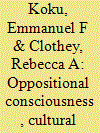

|
|
|
|
|
| Summary/Abstract |
The Internet has potential as a tool for propagation of minority cultures and identities. As China is a multi-ethnic, multilingual society, people of varying cultural backgrounds and across the Chinese diaspora may be found participating in Chinese language sites. However, little attention has been paid to the separate online activity among any of China’s 55 officially recognized ethnic minority groups, such as the Uyghurs, especially in their native languages. In this paper, we consider in what ways digital media such as interactive online community forums (UY: munbar) may be used by one ethnic group, Uyghurs, as a means of mobilizing their community to preserve their culture and support their community. As the majority ethnic group within a region of China noted as among China’s most politically sensitive, Uyghur use of computer-mediated communication provides a rich source of study.
|
|
|
|
|
|
|
|
|
|
|
|
|
|
|
|
| 7 |
ID:
152493
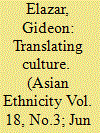

|
|
|
|
|
| Summary/Abstract |
In an attempt to emulate early modern missionaries to Yunnan who engaged in the invention of writing systems for various ethnic groups, contemporary evangelical missionaries in Yunnan have become heavily involved in the realm of linguistics, focused on the preservation of endangered languages. While such activity may potentially be perceived as a challenge to the state-Chinese linguistic hegemony, I argue that the presence of missionary linguists is acceptable to the Chinese authorities as it does not threaten the paramount position of Putonghua but rather serves to integrate minority people into the state system. In addition, based on interviews conducted with a missionary working to produce texts for Kunming’s Buoyi population in their language, I aim to demonstrate how missionary linguists attempt to remold local culture by attempting to reconstruct ethnic identity around a language core. The article is based on fieldwork conducted in Yunnan in 2009–2010 and 2012.
|
|
|
|
|
|
|
|
|
|
|
|
|
|
|
|
| 8 |
ID:
152494
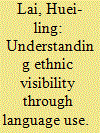

|
|
|
|
|
| Summary/Abstract |
This study investigates how the ethnic visibility of Taiwan Hakka is improved through language use. The usage of a unique Hakka symbolic code is focused on. Based on data from the four Taiwan major newspapers, an analysis with text techniques shows that the code emerges along with social-political developments in Taiwan, with its meaning turning from negative to positive connotation. Its frequency is highly correlated with major political events in Taiwan, with peaks during the two or three years before presidential elections. It illustrates semiotic innovation, extending from Hakka to Hakka non-human, to non-Hakka, and to non-Hakka non-human frames. The salient image it creates increases Hakka ethnic visibility and enhances their ethnic identity. A significant implication is that minority ethnic groups can employ a unique symbolic code, empowering it with positive connotation. Through extensive language use, its representation can raise their ethnic visibility and enhance their ethnic identity.
|
|
|
|
|
|
|
|
|
|
|
|
|
|
|
|
|
|
|
|
|